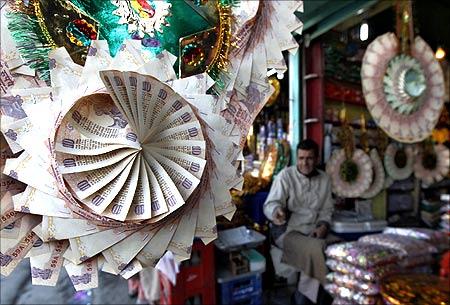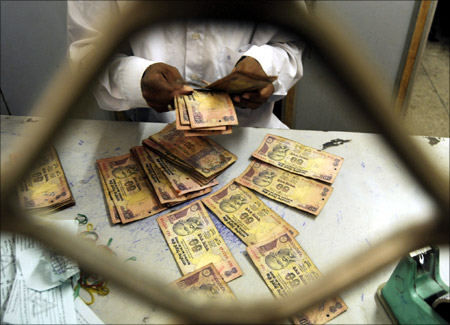Photographs: Jayanta Dey/Reuters Andy Mukherjee
NRIs will abandon rupee-denominated accounts, causing a deposit crunch and worsening the current account deficit, says Andy Mukherjee.
India’s banking system, struggling with a sluggish economy and large loan losses, may lose the only friend it has had the past couple of years: the diaspora.
For every rupee of time deposits that Indian banks have raised from residents in the past year, 13 paise has come from the estimated 25 million people of Indian origin who live in other countries. On all but a fraction of that amount, the currency risk lies with the depositor.
Now the 17 per cent fall in the rupee since February 2012 is threatening to unravel the trade. Not only will banks be hard-pressed to find an alternative source of deposits, the country may find it tough to fill the $75-billion hole in the current account without the help of the diaspora, which shared one-sixth of the financing burden between April and December last year.
...
If NRIs back out, Indian banks face big crisis
Non-resident Indians, known as NRIs, were taken in by the promise of nine per cent annual returns on their deposits. They currently have $47 billion parked in rupee deposits at Indian banks.
Almost half of that money has come into the country since the Reserve Bank of India’s (RBI’s) December 2011 decision to allow banks to offer local interest rates to overseas Indians, provided the latter were willing to stomach the exchange rate risk.
In absolute terms, NRI deposits are small change for the banking system, which has more than $1 trillion in time deposits from residents. But double-digit consumer price inflation in recent years has put off local savers.
Residents’ time deposits are growing at a slower pace than the growth in credit. That is why banks have seized the opportunity to hawk rupee deposits to overseas Indians. At the same time, lenders have been cautious about expanding a separate $15 billion category of foreign currency deposits where they bear the exchange rate risk, not the NRIs (see graph).
...
If NRIs back out, Indian banks face big crisis
Image: An employee arranges Indian currency notes at a cash counter inside a bank in New Delhi.Photographs: Mukesh Gupta/Reuters
The diaspora lapped up what looked like a promising carry trade. After the rupee dropped 16 per cent in the five months to December 2011, it traded close to 53 to the US dollar.
Overseas Indians reckoned that slide was overdone. In pouring cash into term deposits at Indian banks, they not only hoped to earn a high interest rate in a world awash with cheap liquidity, but also bet on further gains from future currency appreciation.
That bet has gone sour. The rupee recently fell dangerously close to 59 to the US dollar, a record low. Depositors have good reason to be spooked: if the rupee weakens any further, a two-year deposit of December 2011 vintage would show no profit when converted back into dollars.
Maturing deposits may depart the country in disappointment, and new money may not rush in to fill the gap.
Expectations of rupee appreciation could have acted as a magnet for capital inflows, but the case for a stronger rupee is weak at present. General elections next year could lead to a wobblier coalition than the one that rules New Delhi at present.
...
If NRIs back out, Indian banks face big crisis
Image: A Kashmiri shopkeeper sits near garlands made of Indian currency notes at a market in Srinagar.Photographs: Fayaz Kabli/Reuters
Meanwhile, persistently higher domestic inflation than India’s trading partners is offsetting the gains from a lower nominal exchange rate. Perversely, a weaker rupee, instead of boosting exports and curbing imports, produces the opposite outcome for India, according to Nomura economist Sonal Varma.
That’s because, unlike other Asian countries, India never built a global manufacturing hub that could take advantage of a competitive exchange rate.
At the same time, economic activity in the United States is firming up, raising expectations that the Federal Reserve’s money-printing press will slow down sooner than previously expected, and that the Fed will start withdrawing some of the massive amounts of liquidity it has injected into the global financial system since the 2008 crisis.
Such expectations, unless they prove to be transient, will imply two things: a stronger US dollar and a higher opportunity cost for global investors looking to put their money to work. Both these trends will dim the appeal of rupee deposits.
...
If NRIs back out, Indian banks face big crisis
Image: A bank employee counts bundles of Indian currency at a cash counter in Agartala.Photographs: Jayanta Dey/Reuters
As a result, Indian banks will have to find alternative sources of deposits. One option may be for them to take on the currency risk rather than pass it on to the NRIs. State Bank of India currently offers 4.2 per cent on five-year US dollar deposits where the lender bears the exchange rate risk.
That return may not be good enough if depositors perceive the opportunity cost of supplying these long-term funds to have gone up due to expectations of higher future US interest rates.
The RBI, however, may not want to allow local banks to take on too much exchange rate risk. In that case, the other option is for the central bank to underwrite the risk. The central bank ran such a scheme for NRIs between 1975 and 1994, closing it down after suffering losses during India’s 1990-91 balance of payment crisis.
Even so, it’s in the RBI’s own interest to find a solution to what could become a big obstacle to the transmission of monetary policy. With deposit growth at a 10-year low, banks are simply not inclined to cut lending rates in response to reductions in the central bank’s policy rate.
...
If NRIs back out, Indian banks face big crisis
Image: An employee sorts Indian currency notes at a cash counter inside a bank.Photographs: Jayanta Dey/Reuters
The much-delayed recovery in output will become more elusive if monetary stimulus does not reach corporate and individual borrowers.
When India faced a dollar crunch in 1998, the government stepped in and sold Resurgent India Bonds to the NRIs. In 2000, it floated India Millennium Deposits.
This time around, the authorities have avoided the ignominy of hat-in-the-hand fundraising efforts purely because NRIs were hungry for the yield they couldn’t get in their home countries. But that scenario is changing.
Recently, Bank Indonesia raised interest rates to keep dollars and euros coming in. With the economy expanding at its slowest pace in a decade, India doesn’t have that option; all the more reason for New Delhi to be vigilant about the shifting risk-return expectations of the diaspora.
The writer is the Asia economics columnist at Reuters Breakingviews in Singapore. These views are his own







article